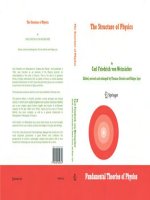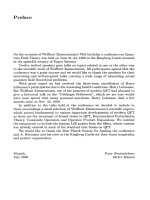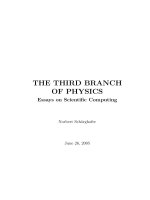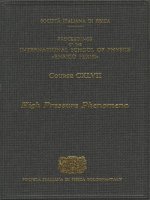- Trang chủ >>
- Khoa Học Tự Nhiên >>
- Vật lý
PROCEEDINGS OF THE INTERNATIONAL SCHOOL OF PHYSICS "ENRICO FERMI"_1 pptx
Bạn đang xem bản rút gọn của tài liệu. Xem và tải ngay bản đầy đủ của tài liệu tại đây (30.8 MB, 386 trang )
SOCIETA ITALIANA
DI
FISICA
RENDICONTI
DELLA
SCUOLA
INTERNAZIONALE
DI
FISICA
"ENRICO
FERMI"
CXLVII
CORSO
a
cura
di R. J.
HEMLEY
e G. L.
CHIAROTTI
Direttori
del
Corso
e di
M.
BERNASCONI
e L.
ULIVI
VARENNA
SUL
LAGO
DI
COMO
VILLA
MONASTERO
3 – 13
Luglio
2001
Fenomeni
ad
alte
pressioni
2002
SOCIETA
ITALIANA
DI
FISICA
BOLOGNA-ITALY
ITALIAN PHYSICAL
SOCIETY
PROCEEDINGS
OF THE
INTERNATIONAL
SCHOOL
OF
PHYSICS
"ENRICO FERMI"
COURSE
CXLVII
edited
by R. J.
HEMLEY
and G. L.
CHIAROTTI
Directors
of the
Course
and by
M.
BERNASCONI
and L.
ULIVI
VARENNA
ON
COMO LAKE
VILLA
MONASTERO
3 – 13
July
2001
High
Pressure Phenomena
2002
Ohmsha
AMSTERDAM, OXFORD, TOKYO, WASHINGTON
DC
Copyright
©
2002
by
Societa
Italiana
di
Fisica
All
rights reserved.
No
part
of
this publication
may be
reproduced,
stored
in a
retrieval
system,
or
transmitted,
in any
form
or any
means, electronic, mechanical, photocopying,
recording
or
otherwise, without
the
prior permission
of the
copyright
owner.
ISBN
1
58603
269 0
(IOS
Press)
ISBN
4 274
90538
1
C3042 (Ohmsha)
Library
of
Congress Catalog Card Number: 2002110641
Production Manager
A.
OLEANDRI
Copy Editor
M.
MISSIROLI
Publisher
IOS
PRESS
Nieuwe
Hemweg
6B
1013
BG
Amsterdam
The
Netherlands
fax:
+31 20 688 33 55
e-mail:
Distributor
in the UK and
Ireland
IOS
Press/Lavis
Marketing
73
Lime Walk
Headington
Oxford
OX3 7AD
England
fax:
+44
1865
75
0079
Distributor
in the USA and
Canada
IOS
Press,
Inc.
5795-G Burke Center Parkway
Burke,
VA
22015
USA
fax:
+1 703 323
3668
e-mail:
Distributor
in
Germany, Austria
and
Switzerland
IOS
Press/LSL.de
Gerichtsweg
28
D-04103 Leipzig
Germany
fax:
+49 341 995
4255
Distributor
in
Japan
Ohmsha, Ltd.
3-1
Kanda Nishiki-cho
Chiyoda-ku, Tokio
101
Japan
fax:
+81 3
3233 2426
Proprieta
Letteraria
Riservata
Printed
in
Italy
Supported
by
UNESCO VENICE OFFICE (UVO-ROSTE)
Supported
by
Consiglio Nazionale delle Ricerche (CNR)
Supported
by
Istituto
Nazionale
di
Fisica Nucleare
(INFN)
Supported
by
Istituto Nazionale
per la
Fisica della Materia
(INFM)
This page intentionally left blank
INDICE
R. J.
HEMLEY,
G. L.
CHIAROTTI,
M.
BERNASCONI
and L.
ULIVI
-
Preface
pag.
XIX
Gruppo
fotografico
dei
partecipanti
al
Corso
» XXX
STATIC
COMPRESSION:
OVERVIEW
AND
TECHNIQUES
R. J.
HEMLEY
and H. K.
MAO
-
Overview
of
static
high
pressure
science
. » 3
1.
Introduction
» 3
2.
Pressure generation techniques
» 6
2.1.
Evolution
of
very high pressure techniques
» 6
2.2.
Measurement
of
pressure
and
stress
» 10
2.3. Variable temperature
» 11
3.
In
situ
high
pressure probes
» 13
3'1. Synchrotron radiation
» 13
3.2.
Polycrystalline X-ray
diffraction
» 14
3.3. Single-crystal X-ray
diffraction
» 15
3.4.
Radial X-ray
diffraction
» 16
3"5.
X-ray
spectroscopy
and
inelastic
scattering
» 16
3'6.
Neutron
diffraction
and
scattering
» 18
3.7. Optical spectroscopy
» 18
3.8. Electrical
and
magnetic methods
» 20
3.9. Other techniques
» 20
4.
Selected applications
» 20
4.1. Dense solid hydrogen
» 20
4.2.
Pressure-induced metallization
and
superconductivity
» 22
4.3. Polymeric nitrogen
and
other
new
materials
» 24
4.4.
"Simple" silicates
and
oxides
» 26
4.5.
Iron
in the
Earth's
core
» 27
4.6.
Pressure
effects
on
biological systems
» 30
4.7.
New
generation
of
high pressure devices
» 30
5.
Conclusions
» 32
VII
VIII
INDICE
T.
YAGI
-
Experimental
overview
of
large-volume
techniques
pag.
41
1.
Introduction
» 41
2.
Development
of
large-volume
apparatuses
» 41
2.1.
Evolution
of the
piston-cylinder apparatus
» 41
2.2.
The
"DIA-type"
apparatus
» 43
2.3. Double-stage apparatus
» 44
2.4.
Use of
sintered
diamond
» 45
3.
Basic technique
for
large-volume experiments
» 46
3.1. Single-stage cubic anvil
» 46
3.2. Double-stage apparatus
» 47
4.
Combination with synchrotron radiation
» 49
5.
Pressure
and
temperature measurements
» 51
6.
Advantages
and
problems
of
large-volume apparatuses
» 52
7.
Current prospects
for
large-volume techniques
» 52
8.
Summary
» 53
R.
BOEHLER,
D.
ERRANDONEA
and M.
Ross
- The
laser-heated
diamond
cell:
High
P-T
phase
diagrams
» 55
1.
Introduction
» 55
2.
The
laser-heated diamond
cell
» 56
3.
Melting experiments
and
phase diagrams
» 59
4.
Alkali
halides
» 61
5.
Aluminum
» 62
6.
Transition metals
» 62
7.
Alkaline-earth metals
» 65
8.
Rare-earth metals
» 65
9.
Noble gases
» 68
J. S.
LOVEDAY
-
Crystallography
at
high
pressure
» 73
1.
Introduction
» 73
2.
Radiation
» 73
3.
Data
collection—powder
diffraction
» 74
3'1. X-ray powder
diffraction
» 75
3'2. Neutron powder
diffraction
» 77
3'3. Powder
diffraction
concluding remarks
» 79
4.
Single-crystal
diffraction
» 79
5.
Data
collection—concluding remarks
» 81
6.
Analysis
» 81
7.
Further sources
of
information
» 83
8.
Conclusions
» 83
Y. K.
VOHRA
and S. T.
WEIR
-
Designer
diamond
anvils
in
high
pressure
research:
Recent
results
and
future
opportunities
» 87
1.
Introduction
» 87
1.l. Advent
of
designer
diamond technology
» 88
INDICE
IX
Experimental pag.
89
2.1.
Chemical vapor deposited diamond
» 90
2.2.
Optical lithography
of
electrical microprobes
and
micro-loops
» 91
Designer diamond anvils—recent experimental results
» 91
3.1. Insulator
to
metal transition
in
potassium iodide studied using
de-
signer diamond anvils
» 91
3.2.
Four-probe electrical resistance measurements
on
fullerene
C
70
using
designer diamond anvils
» 93
3.3. Four-probe electrical resistance measurements
on
single wall carbon
nanotubes samples using designer diamond anvils
» 97
3.4.
Four-probe electrical resistance measurements
on
beryllium using
de-
signer
diamond anvils
» 100
3'5. Magnetic susceptibility measurements with designer loop anvils
» 102
Future opportunities
» 104
4.1. Next generation
of
designer diamond anvils: Multitasking designer
diamond anvils
» 104
DYNAMIC
COMPRESSION: OVERVIEW
AND
TECHNIQUES
W. J.
NELLIS
—
Dynamic experiments:
An
overview
1.
Introduction
2.
Shock compression
2.1.
Simple shock waves
2.2.
Rankine-Hugoniot relations
and
equations
of
state
2.3.
Thermal equations
of
state
and
static
high pressure scales
2'4.
Shock temperatures
and
optical emission spectra
2'5.
Shock wave
profiles
2.5.1.
Elastic-plastic
flow and
material strength
2.5.2.
Shock-induced phase transitions
2.6.
Release
of
shock pressure
by
sound waves
2.6.1.
Speed-of-sound measurements
2.6.2.
Gruneisen parameter
and
phase transitions
2.7.
Electrical resistivity
2.8.
Raman spectroscopy
2.9.
Flash X-ray
diffraction
2.10.
Computer simulations
3.
Synthesis
and
recovery
of
materials
3.1. Nanocrystalline materials
3.2.
Films
3.3. Bond strengths between
film and
substrate
3.4.
Shock-induced defects
and flux
pinning
3.5.
Synthesis
of
hard materials
3.6. Powder consolidation
3.7.
Shock-induced chemical reactions
and
reactivity
3.8. Shock-induced melting
and
rapid
resolidification
3.9.
Explosive systems
to
synthesize diamond particles
109
109
110
111
112
115
116
117
117
118
118
119
119
120
120
120
121
121
122
123
123
123
123
123
124
124
124
X
INDICE
V. E.
FORTOV
and V. B.
MINTSEV
—
Strongly coupled plasma physics
at
megabar pressures pag.
127
1.
Introduction
» 127
2.
Shock waves
and
strongly coupled plasma
» 127
3.
Generators
and
drivers
» 129
4.
Plasma under extreme conditions
» 134
4.1. Equation
of
state
» 134
4.2.
Optical properties
» 137
4.3. Electrical conductivity
» 139
4.4.
Adiabatic expansion
» 141
5.
Conclusions
» 144
THEORY
AND
FUNDAMENTALS
N. W.
ASHCROFT
—
Condensed matter
at
higher densities
» 151
1.
Introduction
» 151
2.
Nuclei
and
electrons: formulating
the
problem
at
variable volume
» 154
3.
Structure:
the
fundamentals
» 158
4.
Ions
and
electrons,
and the
role
of
pressure
» 160
5.
Structure
and
multi-center potentials
» 163
6.
Electrons
in
static
lattices; dynamic lattices
and
their limits
» 167
7.
Liquids
and the
role
of
pressure
» 172
8.
Pair-correlation,
the
Percus argument,
and
liquids
at
high
pressure
» 176
9.
Hydrogen
at
high pressure
» 179
10.
Near ground
states
of
dense hydrogen
» 181
11.
Electronic instability
and
pairing
» 187
12.
Ground-state liquid-like phases
» 189
S.
SCANDOLO
-
First-principles molecular dynamics simulations
at
high
pres-
sure
» 195
1.
Introduction
» 195
2.
Molecular dynamics
» 197
2.1. Basic concepts
» 197
2.2.
Molecular dynamics
at
constant pressure
» 197
2.3. First-principles
MD » 199
2.4.
The
Car-Parrinello method
» 201
2.5.
First-principles
MD at
constant pressure
» 202
2.6.
Empirical potentials
from
first-principles
simulations
» 203
3.
Applications
» 204
3.1. Silicon
» 204
3.2.
Carbon
» 205
3.3. Hydrogen
» 205
3.4. Oxygen
» 207
3.5. Carbon oxides
» 207
INDICE
XI
3.6.
Hydrocarbons pag.
208
3.7.
Water
and
ammonia
» 208
3.8. Other hydrogen-bonded systems:
H
2
S and HBr » 208
3.9. Silicates
and
other
Earth's
materials
» 209
3.10. Iron
» 209
3'11.
Other
simple
metals
» 210
4.
Perspectives
» 210
R. E.
COHEN,
S.
GRAMSCH,
G.
STEINLE-NEUMANN
and L.
STIXRUDE
—
Importance
of
magnetism
in
phase
stability,
equations
of
state,
and
elasticity
» 215
1.
Magnetism
» 215
1.1. Itinerant magnetism
» 217
1.2.
Mott insulators
» 219
1.2.1. LDA+U
» 219
1.2.2.
Self-interaction corrections
» 221
1.2.3. Dynamical mean-field theory
» 222
1.2.4.
Hartree-Fock
» 222
2.
Methods
» 222
3.
Results
and
discussion
» 222
3.1. Overview
of
effects
of
pressure
on
magnetism
» 222
3.2.
Magnetic behavior
of Fe,
FeO,
and CoO
with increasing
pressure
. . . » 224
3.2.1.
Fe » 224
3.2.2.
FeO and CoO » 229
4.
Conclusions
» 235
J P.
POIRIER
—
Rheology:
Elasticity
and
viscosity
at
high
pressure
» 239
1.
Introduction
» 239
2.
Equations
of
state
» 241
3.
Viscosity
of
solids
» 244
4.
Viscosity
of
liquids
» 246
METALS
AND
SUPERCONDUCTORS
K.
SYASSEN
—
Simple
metals
at
high
pressures
» 251
1.
Introduction
» 251
2.
Experimental aspects
» 254
3.
Cesium
» 256
4.
Rubidium
» 261
5.
Lithium
» 264
6.
Sodium
» 266
7.
Concluding remarks
» 268
XII
INDICE
V. V.
STRUZHKIN,
E.
GREGORYANZ,
H. K.
MAO,
R. J.
HEMLEY
and Y. A.
TIMOFEEV
— New
methods
for
investigating
superconductivity
at
very
high
pressures
pag.
275
1.
Introduction
» 275
2.
Overview
of
existing techniques
» 276
3.
Double-frequency modulation method
» 279
3.1. Technique
overview
» 279
3.2. Signal shape
» 282
3.3. Sensitivity
» 284
3'4. Background issues
» 284
4.
Simple metals
» 286
5.
Chalcogens:
sulfur,
selenium, tellurium
» 289
6.
MgB2
and
phonon-assisted electronic topological transition
» 291
7.
Conclusions
» 293
A. F.
GONCHAROV,
E.
GREGORYANZ,
V. V.
STRUZHKIN,
R. J.
HEMLEY,
H. K.
MAO,
N.
BOCTOR
and E.
HUANG
-
Raman
scattering
of
metals
to
very high
pressures
» 297
1.
Introduction
» 297
2.
Experimental
» 298
2'1. Raman technique
» 298
2.2.
Materials
» 300
3.
Raman studies
of
metals
» 300
3.1. Iron
and
Fe
(1
_
x)
Ni
x
alloy
» 300
3.2. Rhenium
» 305
3.3.
MgB
2
and ETT » 308
4.
Conclusions
» 310
SIMPLE
MOLECULAR
SYSTEMS
W. J.
NELLIS
—
Shock
compression
of
hydrogen
and
other
small
molecules
. » 317
1.
Introduction
» 317
2.
Finite temperatures
» 319
3.
Minimum metallic conductivity: hydrogen
» 320
3.1. Experiment
» 320
3.2. Thermodynamic
states
» 322
3.3
Semiconducting
fluid
hydrogen
» 324
3.4. Metallic
fluid
hydrogen
» 325
3'5. Density
at
metallization
» 326
3'6.
Minimum
conductivity
of a
metal
» 327
4.
Nonmetallic
fluid
hydrogen
» 328
5.
Minimum
metallic conductivity: oxygen
and
nitrogen
» 328
6.
Proton conductivity: water
» 331
7.
Hydrocarbons: chemical decomposition
» 331
INDICE
XIII
L.
ULIVI
—
Quantitative
spectroscopy
of
simple
molecular
crystals
under
pressure
pag.
337
1.
Introduction
» 337
1"1.
Molecular crystals
» 337
1.2.
van der
Waals compounds
» 338
2.
Phase
diagrams
» 338
2.1. Nitrogen
» 339
2.2.
Oxygen
» 340
3.
Experimental techniques
» 341
3.1. Sample preparation
» 341
3.2.
Raman
scattering
» 341
3.3. Infrared absorption
» 342
4.
Nitrogen
» 342
4.1. 5-N
2
» 342
4.2.
Stability
of
e-N
2
and
C-N
2
» 344
4.3.
Vibrational coupling
» 344
5.
Oxygen
» 345
5.1. Magnetism
» 345
5.2.
a-S
transition
» 348
5.3. Molecular pairing
» 349
6.
Conclusive remarks
» 352
J. S.
LOVEDAY
—
Hydrogen
bonding
at
high
pressure
» 357
1.
Introduction
» 357
2.
Definitions
» 357
3.
Techniques
» 358
3.1. Vibrational spectroscopy
» 358
3.2.
Structural studies
» 359
3.3.
Ab
initio modelling
» 359
4.
Molecular systems: water-ice
» 360
4.1.
Ice X » 361
4.2.
Disorder
in ice VII » 362
4.3.
Beyond
ice X » 362
5.
Other ices
» 363
51.
Ammonia
» 363
5'2.
Hydrogen sulphide
» 363
6.
Hydroxyl H-bonds
» 364
6.1.
Alkali
hydroxides
» 364
6.2.
Brucite-structured hydroxides
» 364
7.
CIathrate
hydrates
and
other water-gas mixtures
» 365
7.1. Filled-ice clathrates
» 365
7.2.
Cage clathrates
» 365
7.3. Ammonia hydrates
» 366
8.
Summary
» 368
XIV
INDICE
CHEMISTRY
AND
BIOLOGY
G.
JENNER-High
pressure organic synthesis:
Overviewof
recent applications pag.
373
1.
Introduction
» 373
2.
Recent applications
» 376
2.1. Cycloadditions
» 376
2.1.1.
[2 + 2]
Cycloadditions
» 377
2.1.2.
[4 + 2]
Cycloadditions
» 378
2.1.3. 1,3-Dipolar cycloaddition
» 382
2.1.4.
Ene
reactions
» 385
2.2.
Michael
and
related reactions
» 385
2.2.1.
Nitroaldol reaction (also called Henry reaction)
» 385
2.2.2.
Knoevenagel reactions
» 385
2.2.3.
Mannich
reactions
» 385
2.3. lonogenic reactions
» 387
2.3.1.
Morita-Baylis-Hillman (MBH) reactions
» 387
2.3.2. Conjugate addition
of
amines
to a,
/3-ethylenic
compounds
. . » 387
2.4.
Miscellaneous reactions
» 387
2.4.1.
Aromatic
nucleophilic
substitutions
» 387
2.4.2.
Aminolysis
of
epoxides
» 390
2.4.3.
Peptide coupling reactions
» 391
2.4.4.
Addition-substitution reactions
» 391
2.4.5. Polymerization
reactions
» 391
3.
Conclusions
» 391
G.
JENNER
—
Mechanistic studies
of
organic reactions
by
high pressure kinetics
» 395
1.
Introduction
» 395
2.
Determination
of
mechanisms
» 398
3.
Conclusions
» 410
R.
WINTER
-
High
pressure
effects
in
molecular biophysics
» 413
1.
Introduction
» 413
2.
Lipid
mesophases
and
model biomembrane
systems
» 414
2.1. Experimental techniques
» 418
2.2.
Lipid-water
diffraction
patterns
» 420
2.3.
Single-component lipid systems
» 422
2.4.
Binary lipid mixtures
» 428
2.5.
Effect
of
additives
» 434
2.6.
Kinetics
of
phase transformations
in
lipid systems
» 438
3.
Pressure
effects
on
protein structure
» 440
3.1. Experimental techniques
» 441
3.2.
Equilibrium studies
of
protein denaturation
» 442
3.3. Kinetic studies
of the
un/refolding reaction
of
proteins
» 446
4.
Exploitation
of
pressure
effects
in
biotechnology
and
molecular biology
» 448
INDICE
XV
R.
BINI
—
Chemical
transformations
of
molecular
crystals
at
high
pressure
.
pag.
455
1.
Introduction
» 455
2.
Experimental techniques
» 457
3.
Kinetics
» 458
4.
Chemical reactions involving aromatic molecules
» 460
4.1.
Benzene
» 461
4.2.
Furan
» 463
4.3.
Thiophene
» 465
4.4.
Styrene
» 465
4.5.
Conclusions
» 465
5.
Chemical reactions
in
crystals
of
very simple molecules
» 466
5.1. Nitriles
» 466
5.2.
Carbon monoxide
» 468
5.3.
Acetylene
» 469
5.4.
Butadiene
» 471
5.5.
Conclusions
» 473
P. F.
MCMILLAN
—
Solid
state
chemistry
at
high
pressures
and
high
tem-
peratures
» 477
1.
Introduction
» 477
2.
The
emergence
of
high pressure solid
state
science
» 478
3.
"Windowed" experiments
for in
situ studies
of
high pressure phases
and
phase transitions
» 482
4.
Opportunities
for
high pressure solid
state
chemistry
» 482
5.
Thermodynamics,
and
practical considerations
for
high pressure-high
tem-
perature experiments
in
solid
state
chemistry
» 486
6.
Opportunities
and
considerations
for
high pressure-high temperature
syn-
thesis
of new
materials
» 490
7.
Three case histories:
Ge
3
N
4
Si
3
N
4
spinels, icosahedral
B
6
O,
and
LiSi
. . . . » 492
7.1.
Ge
3
N
4
-Si
3
N
4
spinels
» 492
7.2.
Synthesis
of
icosahedral borides
in the
B
6
O-B
6
N system
» 497
7.3. Synthesis
of
lithium monosilicide,
LiSi
» 501
8.
Conclusions
and
outlook
» 505
LIQUIDS, GLASSES,
AND
NANOSTRUCTURES
P. F.
MCMILLAN
-
Liquid
state
polymorphism
» 511
1.
Introduction
» 511
2.
Melting relations
» 516
3. The
case
of
water,
H2O » 518
4.
Pressure-induced amorphisation
and
polyamorphism: general considerations
» 520
5.
Liquid-liquid phase transitions
and the
"two-state"
model
to
interpret melt-
ing
curve maxima
» 526
XVI
INDICE
6.
The
"two-state"
model, liquid-liquid
transitions,
and
extension
to
other
sys-
tems pag.
529
7.
The
relationship with glassy
state
polyamorphism, PIA,
and the
negative
slope
of the
melting curve:
the
general nature
of L-L
phase transitions
. . . » 533
8.
Extensions
of the
two-state model,
and its
implications
for
rheology
» 536
9.
Revisiting Y
2
O
3
-Al
2
O
3
:
the
effects
of the
compositional variable
and the
evolution
towards "normal"
liquid-liquid
immiscibility
» 539
10.
Summary
» 541
A. K.
ARORA
—
Pressure-induced
amorphization
» 545
1.
Introduction
» 545
2. Ice » 546
3.
Quartz
and
other polymorphs
» 549
4.
Other systems
» 554
5.
Effect
of
nonhydrostatic pressure
» 556
6.
Criterion
for PIA » 557
7.
The final
equilibrium
state
» 557
8.
Criterion
for
pressure-induced decomposition
» 558
9. PIA as
kinetically constrained
PID » 560
U. D.
VENKATESWARAN
and P. C.
EKLUND
—
High
pressure
Raman
studies
of
carbon
nanotubes:
Pristine
and
iodine-doped
single-walled
bundles
» 567
1.
Introduction
» 567
2.
Structure
and
symmetry, electronic,
and
vibrational properties
» 568
3.
Pressure dependence
of the
Raman bands
in
pristine SWNT bundles
» 572
4.
Iodine-doped SWNT bundles
» 576
5.
Summary
and
conclusions
» 581
EARTH
AND
PLANETARY
SCIENCE
D.
J.
STEVENSON
-
Introduction
to
planetary
interiors
» 587
1. The
relevance
of
planetary interiors
» 587
2.
How
does
a
planet
differ
from
a
rock
or a
cloud
of
gas?
» 588
3.
What
are
planets made
of? » 588
4.
"Rocks", "ices"
and
"gases"
» 589
5.
What
are the
pressures inside planets?
» 591
6. How do we figure out the
behavior
of
materials
at
high
pressure?
» 592
7.
How can
external
measurements tell
us
about
what's
inside
a
planet?
» 593
71.
Gravity
» 594
7.2.
Topography
» 594
7.3. Rotational
state
and
tidal response
» 594
7.4. Seismicity
and
seismology (broadly defined)
» 595
7.5. Heat
flow » 595
INDICE
XVII
7.6.
Surface
thermodynamic
and
chemical
state
pag.
595
7.7.
Intrinsic magnetic
field and
paleomagnetism
» 596
7.8. Electromagnetic response
» 596
8.
The
gravity
field and
moments
of
inertia
» 596
9.
Observed heat
flows » 599
10.
Expected heat
flows » 599
101. Radioactivity
» 599
10'2.
Secular
cooling
» 600
10.3.
Differentiation
» 600
10.4.
Tides
» 600
11. The
conductive
(or
radiative)
state
» 600
11.l. Terrestrial planets
» 600
11.2.
Giant planets
» 601
12.
Why are
planetary magnetic
fields
interesting?
» 602
13.
What
fields are
observed?
» 602
14.
What
is the
geometry
of
large
fields? » 602
15.
Where
do
magnetic
fields
come
from?
» 604
16.
Why do
some planets have dynamos
while
others
do
not?
» 605
17.
Concluding comments
» 605
W. J.
NELLIS
—
Planetary
interiors:
Experimental
constraints
» 607
1.
Jovian planets
» 607
1.1. Laboratory experiments
» 608
1.2.
Implications
for
Jupiter
» 610
1.2.1. Nature
of the
interior
» 610
1.2.2.
Magnetic
field » 612
2.
Icy
giant planets
» 615
J P.
POIRIER
—
Earth
materials
at
high
pressures
and
temperatures:
The
case
of the
Earth's
core
» 619
1.
Introduction
» 619
2.
Composition
of the
outer core
» 620
3.
Reactions
at the
core-mantle boundary
» 621
4.
Viscosity
of the
outer core
» 621
5.
Energetics
and
cooling
of the
core
» 622
6.
The
phase
of
iron
in the
inner core
» 622
7.
Crystallization temperature
of the
inner core
» 623
8.
Anisotropy
and
deformation
of the
inner
core
» 623
R.
BOEHLER,
L.
CHUDINOVSKIKH
and V.
HILLGREN
—
Earth's core
and
lower
mantle:
Phase
behavior
melting,
and
chemical
interactions
» 627
1.
Introduction
» 627
2.
Seismic velocity discontinuities
in the
Earth's
mantle
» 628
2.1.
Melting temperatures
of
iron
and the
temperature
in the
Earth's
core
» 632
2.2.
Shock melting
of
iron
» 633
XVIII
INDICE
2"3.
Extrapolation
of the
iron melting curve
to the
inner core boundary
(330
GPa) pag.
634
2.4.
Light elements
and the
density
deficit
in the
core
» 635
2.5.
Melting depression
of
iron
by
light elements
» 635
3. The
core-mantle boundary
» 636
3.1. Temperature
» 636
4.
Chemical interaction between
the
core
and the
mantle
» 637
T.
YAGI
—
Behavior
of
Earth
materials
under
deep
mantle
conditions
» 643
1.
Introduction
» 643
2.
Experimental techniques
» 645
2.1. High pressure apparatuses
» 645
2.2.
In
situ X-ray observation using synchrotron radiation
» 646
2.3.
TEM
analysis
of
recovered samples
» 646
3.
Phase
transformations
in the
deep mantle
» 647
3.1. Olivine
» 648
3.2. Pyroxene
» 650
3.3. Garnet
» 650
3.4. Dense
silicate
structure:
Perovskite
» 651
4.
Summary
» 654
Indice
analitico
» 657
Elenco
dei
partecipanti
» 669
Preface
Emergence
of
modern
high
pressure
science
In
many respects,
the
science
of
materials
has
only
fully
utilized
two of its
three
fundamental
tools —the variables
of
temperature
and
chemical composition. Pressure,
the
third fundamental variable altering materials,
is in
many ways
the
most remarkable,
as it
spans some
60
orders
of
magnitude
in the
universe. Yet,
its
true
potential
for
exploring
the
nature
of
materials
was for
years
unfulfilled
for a
number
of
reasons:
the
accessible pressure-temperature conditions were
too
modest
to
cause significant changes
in
many materials, samples under high pressure could
not be
subjected
to
thorough
analyses,
or
theory
was not
sufficiently
well
developed
to
understand
or
predict
the
variety
of
phenomena suggested
by
experiment
or
observed
in
nature. Thus, high pressure
research existed
as a
relatively minor
subfield
within
the
traditional disciplines
of the
physical sciences.
This
state
of
affairs
has
changed dramatically during
the
last
decade. High pressure
science
has
experienced tremendous growth, particularly
in the
last
few
years. With
recent
developments
in
static
and
dynamic compression techniques, extreme pressure
and
temperature conditions
can now be
produced
and
carefully
controlled over
a
wide
range. Moreover,
a new
generation
of
analytical probes, many based
on
third-generation
synchrotron
radiation sources, have been developed
and can now be
applied
for
accurate
determination
of the
structural, dynamical,
and
electronic properties
of
matter
under
extreme conditions. Finally, developments
in
computational techniques
and
advances
in
fundamental
theory tested against
bountiful
new
experimental results
are
both deepening
our
understanding
of
materials
as a
whole
and
guiding subsequent experimental
work
with
new
predictions.
It was for
this reason
that
this course
on
high pressure science
was
held
at the
Inter-
national School
of
Physics "Enrico Fermi"
in
July 2001. Though presented
in a
physics
forum,
the
title
"High Pressure Phenomena"
was
chosen
to
reflect
the
broad scope
of the
XIX
XX
PREFACE
field and the
diversity
of
recent
findings.
Indeed,
the field
spans fundamental physics
and
chemistry,
materials
science
and
technology,
the
geosciences, planetary science
and
astrophysics,
as
well
as
biology.
The
highly interdisciplinary character
of the field was
central
to the
organization
of the
School, though
the
sheer breadth
of the field
meant
that
many topics could
be
treated
in
only
a
cursory
fashion
while
others
were
examined
more
in
depth.
The aim of the
School
was to
present
the
state
of the art in
techniques
used
in
modern high pressure research, highlighting those topics where applications
of
these technique
are
currently having
a
major impact.
The
lectures were therefore
di-
vided into
two
types.
The first
were pedagogic lectures,
in
which basic methods (both
experimental
and
theoretical)
for
investigation
of
matter
at
high pressure conditions were
presented, together with general overviews
of
applications.
The
second type
was
devoted
to
examining special topics.
The
topics
were
interpersed throughout
the 10
days
of the
School
in 47
lectures
and
seminars;
the
written contributions (some containing material
from
multiple lectures)
fall
naturally into
the
following
categories
for the
Proceedings.
I.
Static
Compression: Overview
and
Techniques
II.
Dynamic Compression: Overview
and
Techniques
III. Theory
and
Fundamentals
IV.
Metals
and
Superconductors
V.
Simple Molecular Systems
VI.
Chemistry
and
Biology
VII.
Liquids, Glasses,
and
Nanostructures
VIII.
Earth
and
Planetary Science
Overview
of the
volume
Accelerating
advances
in
static
compression techniques, specifically, those based
on
the
diamond-anvil cell, have been
one of the
major reasons
for the
explosive growth
in
the
high pressure
field. The first
section begins with
an
overview
of the
meth-
ods by
Hemley
and
Mao,
who
briefly
review
the
development
of
opposed anvil meth-
ods as
well
as the
growing array
of in
situ methods
now
used, including X-ray, neu-
tron,
optical,
and
transport
methods with
these
devices
up to
multimegabar
pressures
(>
3Mbar
or > 300
GPa). They then
briefly
discuss several applications
that
comple-
ment
studies presented
later
in the
volume; these include dense hydrogen,
new
materials,
dense
oxides,
and
microbial activity. These techniques
and
applications
can be
com-
pared with those based
on
so-called large volume high pressure devices.
As
reviewed
by
Yagi, these methods
in
principle permit studies with analytical methods
that
require
substantially
larger volumes than
are
possible with conventional diamond-anvil cells.
These include,
for
example,
the
piston cylinder
apparatus,
multianvil
DIA
devices,
and
double-stage
apparatus.
As for
diamond-anvil cells,
an
important recent development
is the
routine
use of
various large volume devices
for in
situ studies with synchrotron
radiation. Though
the
pressure range
of the
"large volume" devices (multianvil presses)
PREFACE
XXI
is
significantly lower
than
that
of
conventional diamond-anvil cells, pressures
as
high
as
50
GPa
have been reached with sintered diamond.
As
discussed
by
Hemley
and
Mao,
a
particularly exciting current development
is the
marriage
of
conventional large vol-
ume
and
diamond-anvil cell techniques based
on the
creation
of
large diamond anvils
by
chemical
vapor deposition.
An
important feature
of the
diamond-anvil
cell
is its use in
generating very high tem-
peratures
(>
5000
K) at
high pressure with laser heating. Boehler
et al.
review
the
laser-heated diamond cell
and its
applications
to
high
P-T
phase diagrams. Introducing
an
example
of the
technique (see also Hemley
and
Mao),
the
lecture reviews melting
ex-
periments
and
phase diagrams
and the use of
various criteria
to
identify
melting. Exam-
ples
of
materials studied include alkali halides, simple metals, transition metals, alkaline
earths, rare earths,
and
noble gases.
The
determination
of
crystal structures
is
central
to
static
high pressure research,
and
underlies
the
topics discussed throughout
the
volume.
Loveday summarizes
the
critically important topic
of
high pressure crystallography,
and
introduces
the
principal types
of
radiation used, X-rays
and
neutrons, comparing
and
contrasting
the
complementary nature
of the
two.
He
also provides
a
brief overview
of
powder diffraction versus single-crystal diffraction, current
efforts
to
expand
both
the
accuracy
and P-T
ranges
of
these techniques,
and
widely
used methods
of
refinement
techniques used
to
determine atomic positions.
Vohra
and
Weir
present
recent developments
in
CVD-based
designer
diamond-anvil
technology,
which
has
matured
in the
last
few
years.
New
results include
the
creation
of
designer eight-probe anvils
for
electrical conductivity measurements
and
designer loop
anvils
for
magnetic susceptibility measurements. They
also
present
design
concepts
for
the
next generation
of
designer diamond anvils with multi-tasking capabilities, including
joule
heating, temperature measurements, diamond strain measurements,
and
integrated
electrical
transport
and
magnetic measurements
that
complement
the
large
anvil
effort
for
a new
generation
of
"large
and
smart"
anvil high pressure devices (see Hemley
and
Mao).
Section
II
provides
an
overview
of
dynamic high pressure (e.g., shock-wave) studies
of
materials.
Nellis
introduces
the
topic,
focusing
principally
on the
gas-gun results. Some
of
the
unique aspects
of
shock compression include
its use in
probing high
P-T
states,
including
the
Hugoniot equations
of
state,
which have been used
in
turn
for
developing
static
high pressure scales.
New
techniques allow accurate determination
of
shock temper-
atures, shock
profiles,
elastic-plastic
flow,
sound speeds, electrical resistivity,
and
X-ray
diffraction.
Recent applications include materials synthesized
and
recovered
from
high
dynamic
pressures, such
as
nanostructures,
films,
superconductors,
and
hard materials.
Fortov
and
Mintsev then discuss more extreme
states
of
matter,
the hot
dense strongly
coupled
plasmas
at
very high temperatures
and
megabar pressures. Beginning with
a
brief
overview
of
shock waves
and
strongly coupled plasmas, including
the
techniques
for
producing
these
states,
the
authors
then summarize
properties
of
plasmas
under extreme
conditions, including equations
of
state,
optical properties, electrical conductivity,
and
behavior
on
adiabatic expansion. Representative examples
of
recent studies
of
elemental
materials
provide
a
meeting ground
for
static
compression
and
lower
temperature
shock
studies.
A
major goal
of
this work
has
been
to
confirm
or
contradict
the
hypothesis
of a
XXII
PREFACE
plasma phase transition
(e.g.,
in
hydrogen,
as
discussed
in
other lectures).
Section
III
provides
an
overview
of the
variety
of
theoretical approaches used
to un-
derstand materials
at
high densities.
Ashcroft
begins with
a
thorough overview
of
funda-
mental theory, beginning with
the
formulation
of the
problem
of the
behavior
of
nuclei
and
electrons with variable volume,
the
role
of
pressure
in
controlling
the
structure
of
ions
as
determined
by
multicenter potentials,
and
electrons
in
static
and
dynamical lat-
tices. Anticipating
the
later experimental discussion
on
pressure
effects
on the
structure
of
liquids,
he
introduces
the
concept
of the
pair
correlation.
Specific
applications
include
hydrogen
at
high pressure,
and the
possibility
of
unusual
effects
of
re-entrant melting
and
liquid-like
phases.
Many
theoretical studies require large scale computational techniques.
Scandolo
introduces
a
particularly important method,
first-principles
molecular dynam-
ics
—the Car-Parrinello method,
which
was first
introduced
at the
1985 "Enrico Fermi"
School. With
its
beginnings
in
classical molecular dynamics with variable shape simula-
tion cells
and
density
functional
theory,
the
Car-Parrinello method
is
well
suited
for
high
pressure
studies, including predictions
of new
phases
and
phase transitions. Applications
to
elemental
materials,
including
Si, C, H, and O,
simple molecular compounds,
and
metals
are
presented,
followed
by
perspectives
on
future
directions.
Complementing
the
above theoretical lectures, Cohen
et al.
examine
new findings
regarding
the
role
of
magnetism
in
affecting
phase
stability,
equations
of
state,
and
elas-
ticity
in
materials under pressure. Following
a
review
of the
basic theoretical treatment
of
magnetism,
the
authors consider Mott insulators (important
for a
variety
of
systems
considered
at the
School)
and the LDA + U
method. Applications include
Fe and
tran-
sition metal oxides (FeO
and
CoO), especially important
for the
Earth's
interior
(as
discussed
in
later
lectures)
as
well
as
from
a
fundamental point
of
view,
in
view
of
recent
experimental
findings
(see Goncharov
et
al).
High
pressure studies
of
rheology, includ-
ing
both elasticity
and
viscosity,
are
important
for
applications
from
materials science
to the
geosciences.
Poirier
reviews fundamental equations, including phenomenological
equations
of
state,
viscosity
of
solids
and how
this
differs
from
the
case
of
liquids,
where
the
applications
to
silicate liquids
is
especially important
in
Earth science (see Boehler
et
al.).
The
above topics lead naturally
to
Section
IV,
which
concerns experimental stud-
ies of
metals
and
superconductors under pressure.
One of the
surprises
in
recent
work
in
this area
has
been
the
structural complexity
of
simple metals
at
high pressure.
As
discussed
by
Syassen, these systems
are far
from
simple: recent examinations (and
re-
examinations) using
new
synchrotron X-ray
diffraction
techniques
are finding
complex
structures, including incommensurate
and
multiple sublattices
in
elemental solids. Struc-
ture
refinements
by
powder
diffraction
(supplemented
with
some single-crystal results,
see
Loveday),
together
with
first-principles
methods discussed above
are
leading
to new
insight
and
systematics. Examples include
Cs, Rb, and Li; the
latter
has
been predicted
to
undergo symmetry breaking transitions with possible parallels
to
dense hydrogen (see
Ashcroft).
In
addition
to
crystallographic studies
of
metals, breakthroughs
in two
additional
areas have
led to the
discovery
of new
phenomena
in
metals, particularly
at
megabar
PREFACE
XXIII
pressures.
The first are the
numerous
new findings in
superconductivity, including
the
creation
of new
classes
of
superconductors
from
large band-gap insulators
at
ambient
pressure. Struzhkin
et al.
provide
an
overview
of
some
of
these developments,
focusing
primarily
on new
magnetic susceptibility techniques
that
can now be
used
to
multi-
megabar pressures (e.g.,
> 200
GPa).
The
lecture summarizes
the
evolution
of
these
methods, culminating
in the
development
of the
double modulation technique
that
is
currently used
at the
very highest
pressures.
Applications
to
simple
metals,
chalcogens,
and
MgB
2
are
described.
A new
development
in
both
the
study
of
metals
at
very high
pressure
(> 100
GPa)
is the
application
of
highly sensitive Raman scattering techniques.
Goncharov
et al.
review
these developments, including details
of the
experimental tech-
nique
and
applications
to Fe and Fe
alloys,
Re, and
MgB2
(also discussed
by
Struzhkin
et
al.).
Historically, simple molecular systems have been
a
particularly important class
of
materials
for
high
pressure
investigations.
With
their
very high
compressibilities,
solid
state
densities
can be
increased
by
over
an
order
of
magnitude with modern techniques,
and
the
evolution
of
major changes
in
physical
and
chemical properties
as a
function
intermolecular distance
can be
monitored.
Of
these systems, hydrogen
has
been
the
focus
of
by far the
most interest since
the
earliest calculations
of
predicted pressure-induced
metallization
for the
solid.
Nellis
presents
an
overview
of
recent dynamic compression
studies
of fluid
hydrogen
and
related
molecular systems, including
the
recent observations
of
minimum
metallic
conductivity
in fluid
hydrogen
at 140 GPa and
high temperature,
after
passing through
an
intermediate semiconducting
state.
The
transition
is
interpreted
as a
Mott transition
in the
high density
fluid. He
goes
on to
present recent measurements
of
minimum metallic conductivity
in
oxygen
and
nitrogen. Notably, both hydrogen
and
nitrogen
are not
metallic
at
these pressures
in the low
temperature solid (see Hemley
and
Mao). Recent evidence
is
presented
for
protonic conductivity
in
water
and
chemical
decomposition
of
hydrocarbons, both
of
which
have been addressed
in
static
compression
experiments.
The
following
two
lectures examine simple molecular systems
from
the
standpoint
of
static compression techniques.
Ulivi
reviews selected molecular systems using vibra-
tional
and
optical spectroscopy. Following
a
discussion
of
molecular systems
in
general,
including
van der
Waals compounds, nitrogen
and
oxygen
are
examined
in
some
de-
tail, primarily
in the
lower
pressure range, where
the
wealth
of
information
that
can
be
obtained
from
spectroscopic studies
has
been demonstrated. This includes
the
mag-
netism
in O
2
,
which
is
unique
for a
simple molecular system,
and the
proposed pairing
of
the
molecules
in
high pressure phases. Loveday's second lecture presents
an
overview
of
hydrogen-bonding
under pressure. Also discussed
in
various other lectures, this relatively
weak
interaction, which controls
the
behavior
of a
vast array
of
materials, including bio-
logical systems, undergoes intriguing changes with pressure
that
reveal
a
great deal about
the
nature
of the
interaction
itself.
Crucial
to the
recent progress
in
this
area
has
been
the
development
of
high pressure neutron
diffraction
techniques,
as
well
as
vibrational
spectroscopic methods
at
higher (i.e., megabar) pressures.
Continuing
the
theme
of
molecular systems, Section
VI
focuses
on the new
insight
XXIV
PREFACE
high pressure
studies
have provided
both
for
synthetic organic chemistry
and the
physical
properties
of
biological systems.
In his first
lecture, Jenner summarizes recent applica-
tions
of
organic synthesis, including pressure
effects
on
rate
constants
and
other
aspects
of
classical physical organic chemistry. Recent applications include investigations
of cy-
coadditions, Michael
and
related reactions,
and
ionogenic reactions. Jenner's second
lecture then shows
how
pressure
effects
on
kinetics
can be
used
to
identify
these
and
other mechanisms. Winter provides
an
overview
of the
high pressure
effects
in
molecular
biophysics,
which
together with other related studies
of
soft
matter constitute another
growing
research area.
After
an
introduction
to
lipid mesophases
and
model biomembrane
systems,
he
summarizes various experimental techniques, including scattering methods,
spectroscopy,
and
high pressure cells (mostly
for < 1
GPa). There
are
surprising
effects
of
these modest pressures
on the
structure, energetics,
and
kinetics
of
transitions
in
lipid
systems; other applications
to
protein structure (both denaturation
and
renaturation),
and the
possible
use of
pressure
to
address
the
protein folding problem.
There
are
impli-
cations
of
these types
of
investigations
in
biotechnology
and
molecular biology, including
the
behavior
of
extremophiles (see Hemley
and
Mao),
food
science,
and
understanding
fundamental
structure-function relationships
in
biomolecules
in
general.
The
following
two
chapters
in
Section
VI
address
new
developments
in
high pressure
solid
state
chemistry. Bini reviews chemical transformations
in
molecular crystals
at
pressures
in the
10–50
GPa
range. Here crystallographic control provided
by the
solid
state,
mixing
of
electronic
states
under pressure,
and a
competition between thermal
and
photochemical reactions distinguish these reactions
from
the
lower pressure solution
chemistry described above. Infrared spectroscopy
is a
particularly
useful
technique
for
such
study,
as
shown
by
examples
of
chemical reactions involving aromatic molecules,
alkenes,
and
other simple molecules, including their kinetics.
McMillan
focuses
on
inor-
ganic solid
state
chemistry
at
high pressures
and
temperatures, beginning with
the
work
of
Bridgman,
the
later synthesis
of
diamond,
and
high
P-T
studies
of
earth materials.
As
in the
work
reviewed
by
Bini, diamond-anvil cell techniques provide
a
uniquely pow-
erful
window
on
reacting materials. This
is
demonstrated
by
recent studies
of
molecular
materials, including
van der
Waals compounds, CO
2
,
and
N
2
O, nitride spinels, icasohe-
dral B
6
O,
and
LiSi.
There
are
important
new
opportunities, including
the
creation
of
new
superhard materials
with
improved techniques
for
recovery
of
materials
from
high
pressure.
Section
VII
reviews selected recent highlights
in the
study
of
liquid, amorphous,
and
nanostructured
materials
under pressure. McMillan reviews
the
topic
of
liquid
state
poly-
morphism
—the evidence
for
transformations
in the
liquid
state
analogous
to
those
found
in
solids.
The
best examples appear
to be
from
supercooled (i.e.,
metastable
liquids),
but
recent results point
to
transitions
in
liquids within their thermodynamic stability
fields.
The
thermodynamic basis
for the
effects,
including
the
relationship
to
melting curve max-
ima, microsopic two-state models,
and the
connection
to
pressure-induced amorphization
are
reviewed.
The
last
topic
is
examined
in
further
detail
by
Arora, beginning with
its
discovery
in ice I and
subsequent
findings in the
silica polymorphs,
and
other materials.
A
metastable transition
that
is
clearly
affected
by the
inhibited kinetics
of
equilibrium
PREFACE
XXV
phase
transitions
and
therefore
temperature,
pressure-induced
amorphization
can
occur
as a
result
of
pressure-induced decomposition (chemical reactions). Finally,
the
high
pressure properties
of
carbon nanostructures
are of
great
interest. Venkateswaran
and
Eklund
present high pressure Raman studies
of
single-walled carbon nanotubes, including
both pristine
and
iodine-doped bundles. They review structure, electronic,
and
vibra-
tional properties
from
the
standpoint
of the
unique symmetry
of
these systems,
and
present recent studies
of the
pressure dependence
of the
Raman spectra
of
pristine
and
iodine-doped bundles.
A
series
of
lectures
on
Earth
and
planetary interiors
are
collected
in the final
section.
The
section begins with
a
broad introduction
to the field of
planetary interiors
as a
whole
by
Stevenson.
The
interior structure, composition,
and
dynamics
of the
planets contain
a
great deal
of
information about
the
evolution
of our
Solar System.
In
addition, they
serve
as a
testing ground
for
high pressure theory
and as
distinctly natural high pressure
experiments
in
which
to
observe
the
behavior
of
materials.
The
major classes
of
planetary
materials include rocks (minerals), ices (molecular systems),
and
gases. Approximate
methods
can be
used
to
determine
the
pressure
as a
function
of
depth within planets (the
pressures
are
known with high accuracy
if
seismological measurements
can be
performed).
External measurements
that
reveal information about internal
state
and
past
history
of
the
planet include heat
flow and the
character
of
magnetic
fields.
Nellis presents
experimental
constraints
obtained
from
recent shock wave experiments.
An
important
recent
application
to the
Jovian interiors
(of
Jupiter
and
Saturn)
is the
observation
of
electrical conductivity
in fluid
hydrogen discussed above
and how
convection
can
give
rise
to the
planet's
large
and
turbulent magnetic
field.
These
interiors
may be
compared
with
those
of the icy
giant planets (Uranus
and
Neptune),
which
are
composed
of
water
and
water-rich molecular mixtures.
The final
three lectures summarize
the
great
amount
of
recent high pressure studies
of
our
planet's interior. Poirier provides
an
overview
of the
physics
and
chemistry
of the
Earth's core.
He
outlines principal current problems, including composition, reactions
at the
core-mantle boundary, viscosity, energetics
and
cooling
of the
outer core,
as
well
as the
problem
of the
phase, crystallization, anisotropy
and
deformation
of the
inner
core.
Boehler
et al.
examine materials
of the
Earth's
core
and
lower mantle,
focusing
on
phase behavior, melting,
and
chemical reactions
for
major phases.
The
review shows
how
differences
in the
determinations
of
melting temperature
of
iron give rise
to the
rather
different
estimated temperatures
for the
center
of the
planet (compare Hemley
and
Mao;
Cohen
et
al.),
and the
role
of
additional elements
is
examined. Measurements
of
melting
of
silicates imply
a
large thermal boundary layer
at the
core-mantle boundary.
The
high
P-T
behavior
of
deep mantle materials
is
also reviewed
in
Yagi's second lecture.
Beginning
with
an
overview
of the
structure
of the
mantle,
he
reviews
the
diversity
of
techniques including opposed anvil, multianvil,
and
laser-heated
diamond-anvil cells.
These
are
supplemented with
in
situ X-ray measurements discussed elsewhere
as
well
as
analyses
of
recovered samples
by
energy-resolved transmission electron microscopy,
a
technique
that
complements
the
X-ray spectroscopy
and
inelastic
scattering
discussed
earlier. Recent studies
of the
transformations
of
upper mantle minerals
(olivine,
pyroxene,









